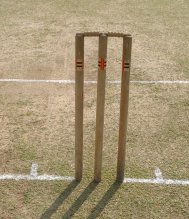
 |
| Index | |
|
|
|
|
|
| Wicket  The word wicket possibly derives from an Anglo-Saxon word for a wicket-gate, used as the target by shepherds playing a very early form of cricket. The word today has three common usages... 1. The physical wicket, which, when fully made up, consists of three stumps and two bails. It measures nine inches (22.86 cm) wide and a maximum of twenty-eight and a half inches (72.39 cm) high (allowing for the bails when in position), with a slightly smaller wicket for junior players. Because everyone can see where the physical wicket is situated it is often used as a general description of where the batter is - 'Jones walked to the wicket'; 'Wasim, standing upright at the wicket, hit the ball hard', etc. 2. The word is also used as a part of the expression of a team's score, for example 'the score at the end of the first day was 345 for 6 wickets' - meaning that 6 batters had been dismissed by that time. If the side batting last win a match, the result is expressed in terms of 'wickets'. For example, if team A score 250 for (the loss of) 7 wickets, and team B then score the 251 required for (the loss of) 2, they will be described as having won the match 'by 8 wickets', since, at the moment they won, they still had eight of their ten wickets intact. 3. 'Wicket' is also used as a general term for being dismissed, however that dismissal occurs, even when the physical wicket was not involved at all - hence expressions like 'Smith lost his wicket when caught on the boundary.' Finally, some commentators, journalists and cricket writers are fond of using remarks such as 'it's a turning wicket'. The two words wicket and pitch were widely recognised as interchangeable until 1947, when the pitch was defined in the Laws for the first time. So, these days, the word wicket does not mean the same as the pitch. |
||||||